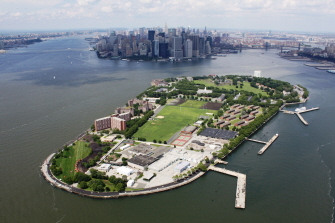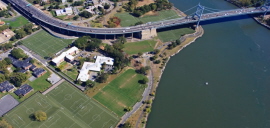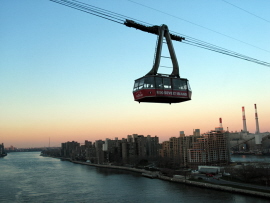By Oliver Hartman, www.oliverhartman.com
Manhattan is the least islandy-island I’ve been on. Fish at the market has travelled hundreds of miles at the very least, serenity comes in the form of empty subway cars, and while people are chronically late, it cannot be attributed to a collective agreement to follow “island time” in the Caribbean sense of the phrase. In fact, only because it is surrounded by water do I consider it one. Here are a few of the other Manhattan islands that are a little more tranquil.
Governors Island
Rumored to have been purchased for 2 axe heads, a string of beads, and a few nails, Governors Island remained rural until 1702 when a great permanent home was built for British governors. The years that followed were full of historical drama. By 1710, it was used as a quarantine for German refugees and contaminated  ships. In the 1800s, it became reinforced with forts and was home to the Army of the East. During the Civil War, it was a recruiting center and used as a prison camp for Confederate soldiers. Later (in 1966), the Coast Guard accepted jurisdiction over the island and stayed for 30 years. ships. In the 1800s, it became reinforced with forts and was home to the Army of the East. During the Civil War, it was a recruiting center and used as a prison camp for Confederate soldiers. Later (in 1966), the Coast Guard accepted jurisdiction over the island and stayed for 30 years.
It was opened to the public for the first time in 1976 for fireworks and a parade of tall ships to celebrate America’s bicentennial. And then, in 2003, was returned to the people of New York when it was sold to the city for $1 by the federal government.
Its popularity has been growing ever since. The northern 92 acres are historic and are open to the public for picnics, tours, concerts, and bicycling. For the past 3 summers they have also hosted a polo tournament, attended last year by Prince Harry. The southern 80 acres are not historic and will be the site of a future multi-purpose development that combines park and public spaces.
Details: Open Friday-Sunday and all holiday Mondays from May 27-September 25. Free ferries depart from the Battery Maritime building (10 South Street), which is just east of the Staten Island Ferry. In Brooklyn, free ferries leave from Pier 6 in Brooklyn Bridge Park. The free public ferries to Governors Island take bicyclists and pedestrians to Governors Island during its public hours (Friday, 10am to 5 pm), Saturday, Sunday and Holiday Mondays, from 10am to 7 pm. On Fridays only, you can also take NY Harbor Water Taxi, which leaves from the South Street Seaport.
Randall’s Island
In 1835, the city of New York purchased Randall Island from the heirs of Jonathan Randel (for whom it was named after, albeit with a different spelling), and converted it into a holding tank for undesirables: the Inebriate Asylum, Idiot Asylum, a homeopathic hospital, the State  Emigrant House of Refuge, and the House of Refuge for juvenile delinquents were all here. In 1933, stewardship of the island was given to Parks & Recreation, which, under direction of Robert Moses began to transform it. Emigrant House of Refuge, and the House of Refuge for juvenile delinquents were all here. In 1933, stewardship of the island was given to Parks & Recreation, which, under direction of Robert Moses began to transform it.
Now the island is a center of recreation with a stadium built to Olympic standards where Jamaican track star Usain Bolt set a new 100m world record in 2008; a 20-court tennis complex showcases US tennis stars for World Team Tennis like Andy Roddick and Serena Williams; and over 60 sports fields for sports like soccer, baseball, football, lacrosse, rugby, and field hockey. There are also 9 acres of restored wetlands and salt marsh, and a network of bicycle and pedestrian paths that follow the waterfront around the whole island.
Details: The M35 bus runs to the Island from the NW corner of 125th Street and Lexington Ave. Transfer is available from the Lexington 4, 5 or 6 trains at 125th Street. If you have a car, take the Randall’s Island exit off the RFK bridge.
By foot, you can cross the pedestrian bridge that is rooted at 103rd Street from the East River Esplanade. The bridge is open from 6am-midnight everyday. (Note: The bridge will be closed from through mid-2011 for construction.)
Roosevelt Island
After switching hands a few times, “Hog Island”, as it was known due to Dutch farmers and their pigs, came back into New York City’s possession and was promptly made the staging ground for a famous penitentiary – Mae West served 10 days for her crude improvisation in her early play called “Sex”. Joining it were also a small pox hospital and a Lunatic Asylum whose poor management and practices were exposed by undercover reporter Elizabeth Cochrane who pretended to be a patient for 10 days. Later, in 1969, a 99-year lease was given to NY State’s Urban Development Committee and a project to build housing for 20,000 residents was spearheaded. by undercover reporter Elizabeth Cochrane who pretended to be a patient for 10 days. Later, in 1969, a 99-year lease was given to NY State’s Urban Development Committee and a project to build housing for 20,000 residents was spearheaded.
While mostly a residential island, there are some notable historical sites. One, the famous Octagon, part of the New York City Lunatic Asylum, built in 1834, was restored and converted into luxury apartments. The Chapel of the Good Shepherd, the Ruins of the Smallpox Hospital, and Blackwell House – the 6th oldest house in New York City-are also worth a visit, as is a ride on the Tramway (featured in motion pictures such as Billy Crystal’s City Slickers and Sylvester Stallone’s Nighthawks) which was the first commuter aerial tramway in North America.
Details: Tramway is located at 59th Street and 2nd Ave.
Train: F train to Roosevelt Stop
For more info on visiting NYC and islands, NYCGo.com
|
|
|

